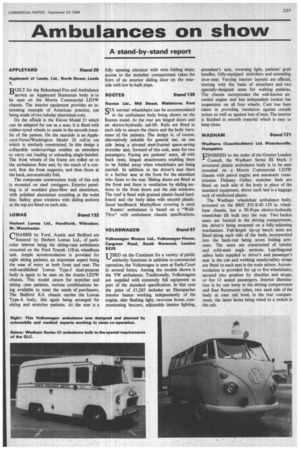Ambulances on show
Page 233

If you've noticed an error in this article please click here to report it so we can fix it.
A stand-by-stand report
APPLEYARD Stand 28
Appleyard of Leeds. Ltd.. North Street, Leeds 7.
BUILT for the Birkenhead Fire and Ambulance 'service an Appleyard Statesman body is to be seen on the Morris Commercial LD5W chassis. The interior equipment provides an interesting example of American practice, use being made of two tubular aluminium cots.
On the offside is the Klever Model 21 which can be adapted for use as a seat; it is fitted with rubber-tyred wheels to assist in the smooth transfer of the patient. On the nearside is an Appleyard-Ferno/Washington Model 26 roll-in cot which is similarly constructed. In this design a collapsible undercarriage enables an attendant to carry out loading or unloading single-handed. The front wheels of the frame are rolled on to the ambulance floor and, by the touch of a control, first the front supports, and then those at the back, automatically fold.
The composite construction body of this unit is mounted on steel outriggers. Exterior panelling is of moulded glass-fibre and aluminium, with polished aluminium moulding at the waist line. Safety glass windows with sliding sections at the top are fitted on each side.
LOMAS Stand 132
Herbert Lomas Ltd., Handforth, Wilmslow, Nr. Manchester.
CHASSIS by Ford, Austin and Bedford are featured by Herbert Lomas Ltd., of particular interest being the sitting-case ambulance mounted on the Ford Transit I 18-in, wheelbase unit. Ample accommodation is provided for eight sitting patients, an important aspect being the ease of entry at both front and rear. The well-established Lomas Type-7 dual-purpose body is again to be seen on the Austin LD5W chassis. This model caters for stretcher and sitting case patients, various combinations being available to meet the needs of purchasers. The Bedford KA chassis carries the Lomas Type-A body, this again being arranged for sitting and stretcher patients. At the rear is a fully opening entrance with twin folding steps; access to the stretcher compartment takes the form of an exterior sliding door on the nearside with low in-built steps.
ROOTES Stand 139
Rootes Ltd., Mill Street, Maidstone, Kent
cpc normal wheelchairs can be accommodated in the ambulance body being shown on the Rootes stand. At the rear are hinged doors and an electro-hydraulic tail-lift. Rails are fitted at each side to secure the chairs and the body harnesses of the patients. The design is, of course, alternatively suitable for general use, on one side being a pivoted steel-framed space-saving stretcher and, forward of this unit, seats for two passengers. Facing are patients' seats, all with back rests, hinged attachments enabling them to be folded away when wheelchairs are being carried. In addition to the driver's seat there is a further seat at the front for the attendant who faces to the rear. Sliding doors are fitted at the front and there is ventilation by sliding sections in the front doors and the side windows. The roof is lined with grained plastic-faced hardboard and the body sides with smooth plasticfaced hardboard. Marleyfloor covering is used.
Rootes' ambulance is based on a "WalkThru" with ambulance chassis specifications.
VOLKSWAGEN Stand 67
Volkswagen Motors Ltd., Volkswagen House, Cargreen Road, South Norwood, London 8E25
T TSED on the Continent for a variety of public
authority functions in addition to commercial operation, the Volkswagen is seen at Earls Court in several forms. Among the models shown is the VW ambulance. Traditionally, Volkswagens are supplied with extremely full equipment as part of the standard specification. In this case the price of £1,265 includes an Eberspacher interior heater working independently of the engine, also flashing light, two-tone horns, communicating buzzers, adjustable interior lighting, attendant's seat, reversing light, patients' grab handles, fully-equipped stretchers and extending door-step. Varying interior layouts are offered, starting with the basis of stretchers and two specially-designed seats for walking patients. The chassis incorporates the well-known aircooled engine and has independent torsion bar suspension on all four wheels. Care has been taken in providing insulation against outside noises as well as against loss of heat. The interior is finished in smooth material which is easy to keep clean.
WADHAM Stand 121
Wadhams (Coachbuilders) Ltd. Watedooyille, Hampshire
piNISHED to the order of the Greater London
Council, the Wadham Series III Mark 3 structural plastic ambulance body is to be seen mounted on a Morris Commercial LD5W chassis with petrol engine and automatic transmission. Delaney Gallay stretcher beds are fitted on each side of the body in place of the standard equipment; above each bed is a luggage rack of reinforced plastic.
The Wadharn wheelchair ambulance body, mounted on the BMC FG:K40 129 in. wheelbase chassis, has a Hi-Pope electro-hydraulic wheelchair lift built into the rear. Two bucket seats are located in the driving compartment, the driver's being mounted on a fully-adjusting mechanism. Full-length tip-up bench seats are fitted along each side of the body, incorporated into the back-rest being seven folding armrests. The seats are constructed of tubular and mild-steel angle sections. Lap/diagonal safety belts supplied to driver's and passenger's seat in the cab and webbing steady/safety straps are fitted to each seat in the main saloon. Accommodation is provided for up to five wheelchairs, secured into position by shackles and straps, or for 12 seated passengers. Interior illumination is by one lamp in the driving compartment and four fluorescent tubes, two each side of the body at cant rail level, in the rear compartment, the latter "Series being wired to a switch in the cab.








































































































































































































































































































































































